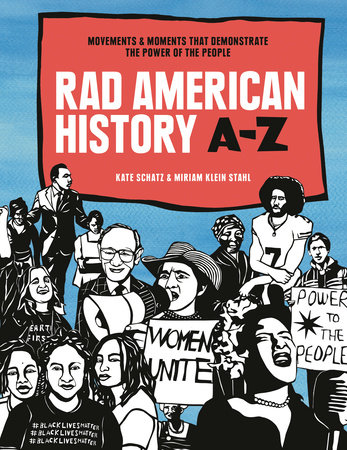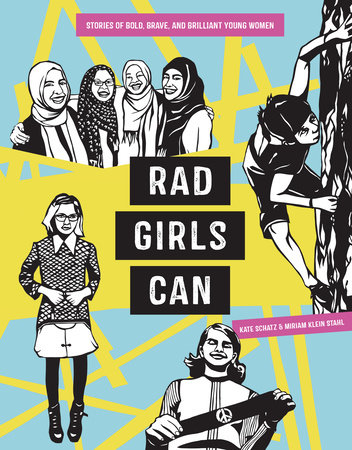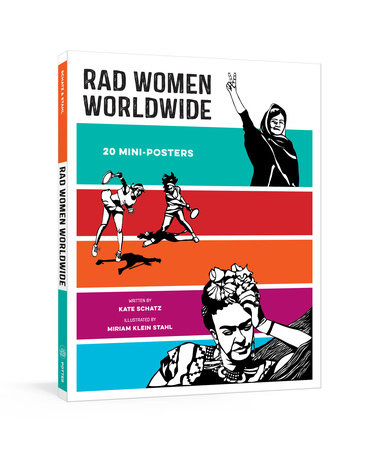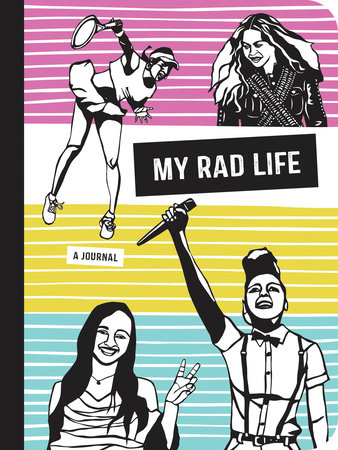Excerpt
Rad American History A-Z
Introduction
CURB CUTS, CONSCIOUSNESS-RAISING, and constitutions. Supreme Court cases, voting rights, quilts, zines, and witches. Redwood trees and punk shows. Climate strikes and labor laws. The New Deal, the Bonus Army, and the only all-girl integrated jazz band in the US.
Librarians who fight for free speech. Athletes who take a knee. Children who march for freedom. Welcome to
Rad American History A–Z, a book that explores several centuries of radical, powerful, and fascinating American histories.
We begin on Alcatraz Island in the San Francisco Bay, where hundreds of Native Americans occupied an abandoned prison to draw attention to the plight of their people in 1969. We end in New York City’s Zuccotti Park, the tiny public space in lower Manhattan where the Occupy Wall Street movement began in 2011. In between, we range from Reconstruction to Riot Grrrl, from the East Coast to the West, and from the 16th century to the 21st.
We’ve selected these stories for a number of reasons. For one, we think they’re rad, in the sense that they’re just really cool. For another, they also present different perspectives on how those who are considered radical have shaped and transformed America. These are people and groups with big ideas and outrageous creativity; people who have dared to be different, to fight for their rights, to create something new, and to defy unjust laws and corrupt power. In the words of Representative Alexandria Ocasio-Cortez: “It only has ever been radicals that have changed this country.”
RAD AMERICAN HISTORY A–Z is, of course, incomplete—because it’s a collection of stories about history, and every single book about history is incomplete. It’s impossible to include every important moment in American history, or every major significant social movement. Think of this as a sampling, a glimpse into just a few of the thousands of stories that have contributed to American history, and to the centuries-old movement for justice, equality, and truth.
Rad American History A–Z is also biased—toward the stories that don’t get told, the ones many readers won’t have heard of: stories of women, people of color, immigrants, indigenous people, and those whose histories aren’t always seen as important or central to the American story. These are the stories and truths that many people would prefer to deny, the details that often get ignored, glossed over, sanitized, or left out—especially in history books.
Here are stories of police brutality, racial terrorism, discriminatory laws and policies, the repression of women, and the mass incarceration of innocent Americans. But here too are stories of triumph, resilience, resistance, creation, and hope. The history of America cannot be boiled down to one single story, told from one single perspective—it is thousands and thousands of compelling, inspiring, sometimes shocking stories, told from the points of view of the diverse humans who’ve populated this land.
Rad American History A–Z explores how we got to where we are now—and what we need to know about our histories in order to create a just, sustainable future.
HISTORY IS NEVER NEUTRAL—it’s never
not political or somehow separate from culture and experience. The histories we learn are always shaped by the one doing the documenting, the teaching, the writing, the telling.
As artists, we made specific decisions on every page of this book. Some were practical: details got left out, due to word count and page limits. But beyond that, we made very intentional choices about which stories to include—and how to tell them. Where to begin and end? What points of view do we include? What might surprise, excite, and engage readers? What do we want people to know about America?
Our approach to answering these questions was to talk to people: to scholars and historians and journalists and movement leaders. To college professors and high school and middle school history teachers. And also: to the people who were
there. The people who have participated in the moments and movements we explore, and those who are descended from the folks who once did. These generous and wise individuals shared their insight, their experiences, and their expertise, and helped us shape each story, and the book as a whole.
We asked them: What stories are you excited to see included? What is
not there? Who and what are we overlooking? We reached out to people about specific stories and asked: What’s a little-known aspect of this history that we might explore? What do people often get wrong about this event or movement—and how does your community want this story to be told?
LANADA WAR JACK, the first Native American woman to attend UC Berkeley, described what it was like to arrive on Alcatraz Island that night in 1969. Leroy Hill, a speaker for the Grand Council of the Haudenosaunee (Iroquois) Confederacy, clarified the political and cultural history of his people.
Eric Reiss shared stories about his late mother, Dr. Louise Reiss, whose pioneering work on the effects of nuclear radiation has long gone unrecognized. Tony Uranday, the son of the late farmworker and organizer Esther Uranday, also offered memories of growing up with a remarkable mother.
Judy Nagosian and Joan Ditzion talked about what it was like to write
Our Bodies, Ourselves, the bestselling women’s health book of all time. Barbara Smith explained specific details about the early days of the Combahee River Collective. Alicia Garza discussed how she feels about being called the “founder” of Black Lives Matter.
Musician Corin Tucker and artist Tammy Rae Carland shared memories of their first encounters with Riot Grrrl. Amanda Yates Garcia described the witchcraft lineage she’s descended from. David Solnit offered anecdotes from the antinuclear protests he attended in Nevada in the 1980s. And multiple young climate activists detailed what they’re doing to protect the planet—and why it matters so much.
This process was especially important because of our own limited experiences and perspectives as white women creating a book like this. While we strive to be antiracist, and to share histories in the most respectful, accurate ways, we were brought up in educational and cultural systems that placed white people—mostly men—at the center of history and failed to teach us so much. Part of writing a book like this is unlearning our own internalized white supremacy, and we’re grateful to those who have offered corrections and pointed to places where we’ve needed to deepen our research and do better.
WE ALSO DREW UPON our own experiences and memories—these are valid forms of history-telling too. We toured a Center for Independent Living; we explored the extensive archives of Sister Corita Kent with the archivists who preserve her work. Miriam remembered her days as a young punk attending Riot Grrrl shows; Kate looked back at photos from Earth First! demonstrations she attended at Headwaters Forest in the 1990s; and we both recalled moments from the Occupy movement.
Miriam’s great-aunt Doris worked at the Triangle Shirtwaist Factory. She wasn’t there on the day of the deadly fire, but she’s there in the illustration that Miriam created. And the X chapter (pages 148–149) is inspired by our own high school history notebooks. It represents both the histories we
wish we’d been taught, as well as the histories we have taught ourselves in the years since, as teachers, as activists, as history geeks, and as feminists looking to the past in order to understand our future.
We learned a
lot while making this book, and we hope that you’ll also learn a few new things—about your history, your culture, your country, and yourself.
Thanks for reading, and for being
rad.
Love,
Kate & Miriam









